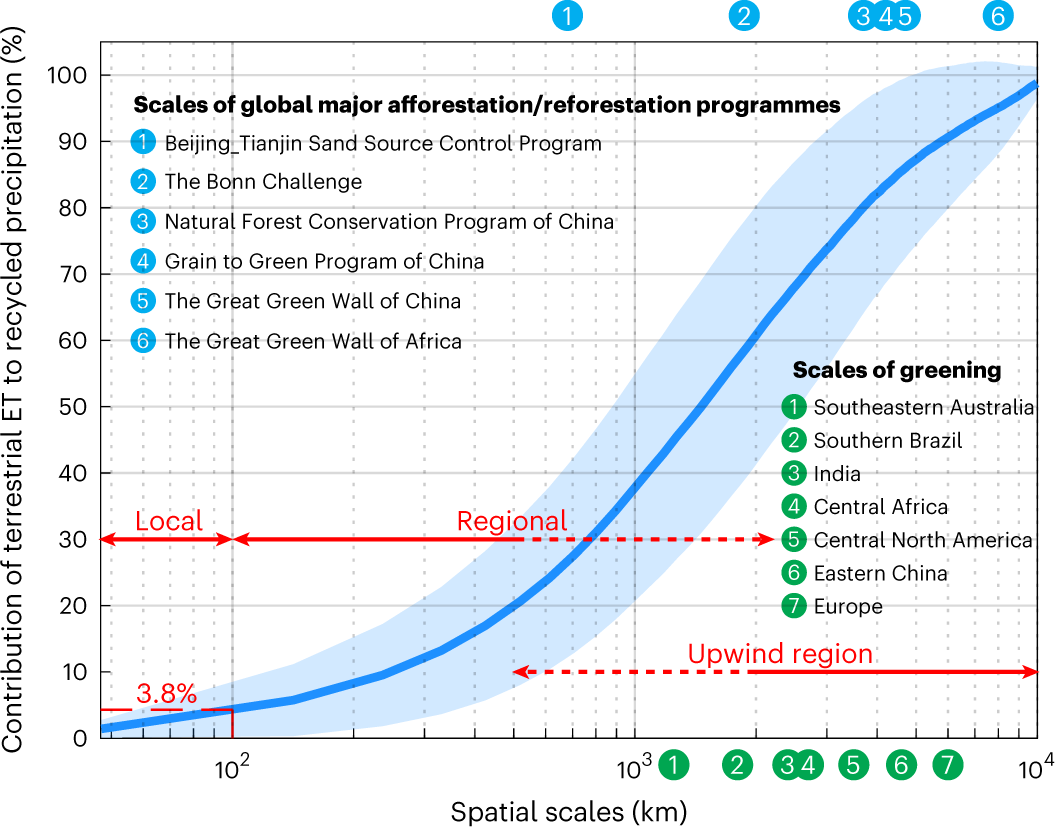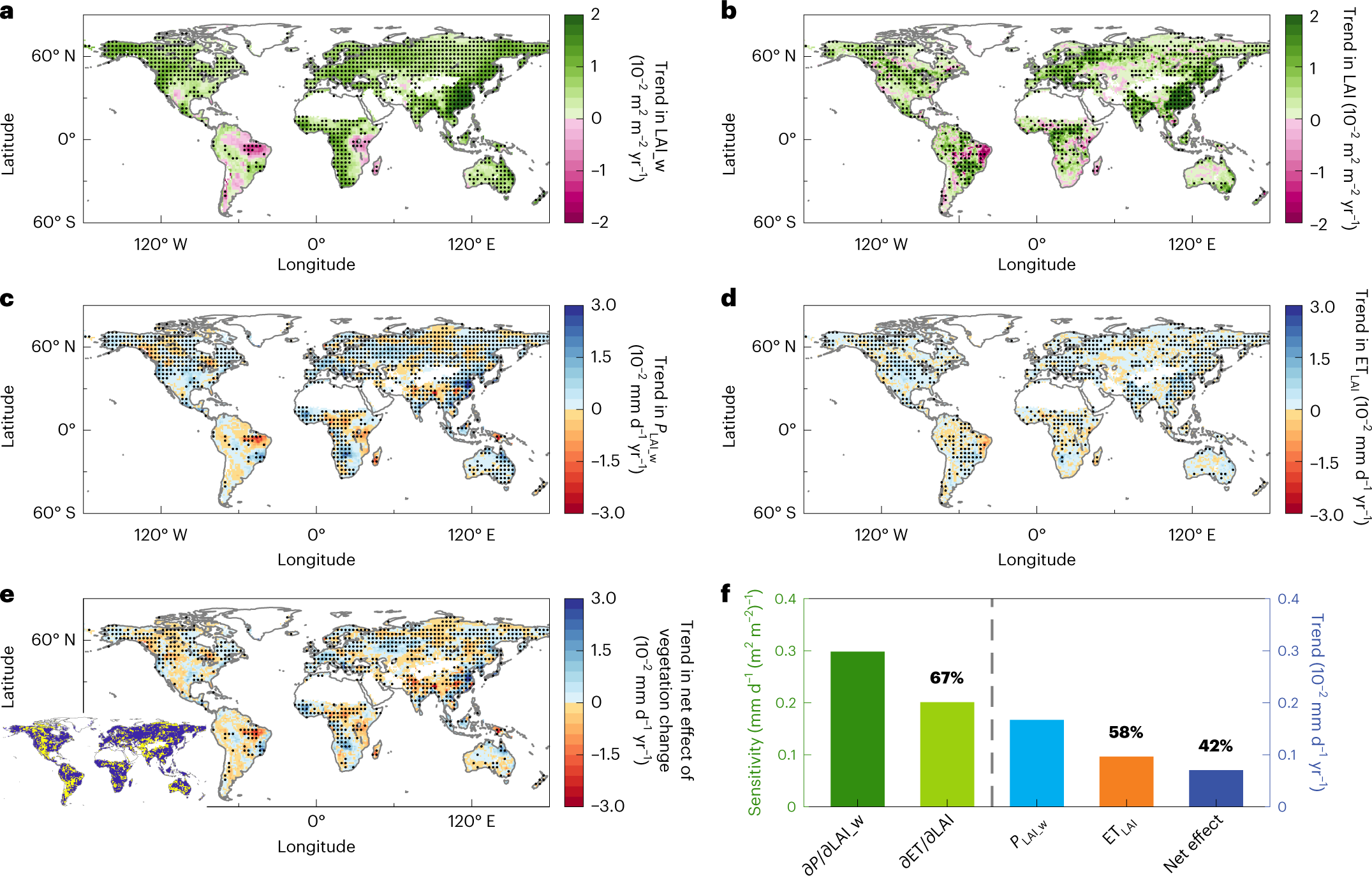文章信息:Cui Jiangpeng,Lian Xu, Chris Huntingford, Luis Gimeno, Wang Tao, DIng Jinzhi, He Mingzhu, XU Hao, Chen Anping, Pierre Gentine, & PIao Shilong. (2022). Global water availability boosted by vegetation-driven changes in atmospheric moisture transport. Nature Geoscience: 15(12), 982–988. https://doi.org/10.1038/s41561-022-01061-7
整理人:杨文,2023级硕士生
整理时间:2024年7月7日
Abstract: Surface-water availability, defined as precipitation minus evapotranspiration, can be affected by changes in vegetation. These impacts can be local, due to the modification of evapotranspiration and precipitation, or non-local, due to changes in atmospheric moisture transport. However, the teleconnections of vegetation changes on water availability in downwind regions remain poorly constrained by observations. By linking measurements of local precipitation to a new hydrologically weighted leaf area index that accounts for both local and upwind vegetation contributions, we demonstrate that vegetation changes have increased global water availability at a rate of 0.26 mm yr−2for the 2001–2018 period. Critically, this increase has attenuated about 15% of the recently observed decline in global water availability. The water availability increase is due to a greater rise in precipitation relative to evapotranspiration for over 53% of the global land surface. We also quantify the potential hydrological impacts of regional vegetation increases at any given location across global land areas. We find that enhanced vegetation is beneficial to both local and downwind water availability for ~45% of the land surface, whereas it is adverse elsewhere, primarily in water-limited or high-elevation regions. Our results highlight the potential strong effects of deliberate vegetation changes, such as afforestation programmes, on water resources beyond local and regional scales.
摘要:地表水资源的可用性,即降水减去蒸发蒸腾,可能会受植被变化的影响。 这些影响可能是局部的,由于蒸腾蒸腾和降水的改变,或者是非局部的,由于大气湿度输送的变化。 但是,关于风下地区植被变化对水资源可用性的远程关联仍未受观测结果严格限制。 通过将局部降水测量与新的水文加权叶面积指数相关联,该指数考虑了局部和上风植被贡献,我们证明植被变化已经以每年0.26 mm的速度增加了全球水资源可用性2001年至2018年期间。 临界地,这一增加已经减缓了全球水资源可用性最近观察到的下降约15%。水资源的增加是由于降水相对于蒸发蒸腾在全球陆地表面的超过53%上升更多。 我们还量化了全球陆地区域植被增加可能对各给定位置的水文影响。 我们发现,在全球陆地表面约45%的地方,增强的植被对地表水资源的本地和风下可用性都是有益的,而在其他地方,主要是在水资源有限或高海拔区域,它是有害的。 我们的研究结果突出了有意的植被变化对局部和区域规模以外的水资源的潜在强效应,比如植树造林计划。

图 不同空间尺度下陆地蒸发蒸腾对循环陆地降水的贡献
蓝色粗线表示平均值,阴影区域表示一个标准偏差。根据Link等人41的数据集,将百分比计算为N×N网格框内的蒸散量(ET)对中心网格内循环降水的贡献。N等于1、3、5,依此类推。注意横轴是对数刻度。红色箭头表示局部、区域尺度或逆风区域的空间范围,虚线表示区域尺度和逆风尺度之间的重叠。蓝圈和绿圈表示全球主要造林/再造林方案的空间尺度和Earth1的区域绿化。左下角的红色数字(3.8%)表示陆地ET在102公里的空间尺度上对循环降水的全球陆地平均贡献。

图 LAI的趋势及其对陆地水可利用性的净影响
a,b,LAI_w(a)和LAI(b)的趋势。点划线表示趋势在统计上具有显着意义(P < 0.05)的区域。c,PLAI_w的趋势。d,与LAI变化相关的蒸散发趋势(ETLAI)。e,植被变化对当地陆地水资源可用性的净效应的趋势(PLAI_w减去ETLAI)。左下角插图指示绝对ETLAI较大(黄色)或较小(深蓝色)的地区。f,全球陆地平均敏感度(∂P/∂LAI_w,∂ET/∂LAI;左侧刻度)和水资源变化(PLAI_w,ETLAI和净效应;右侧刻度)。柱顶部的数字表示相对于∂P/∂LAI_w或PLAI_w值的百分比。
原文链接:https://www.nature.com/articles/s41561-022-01061-7